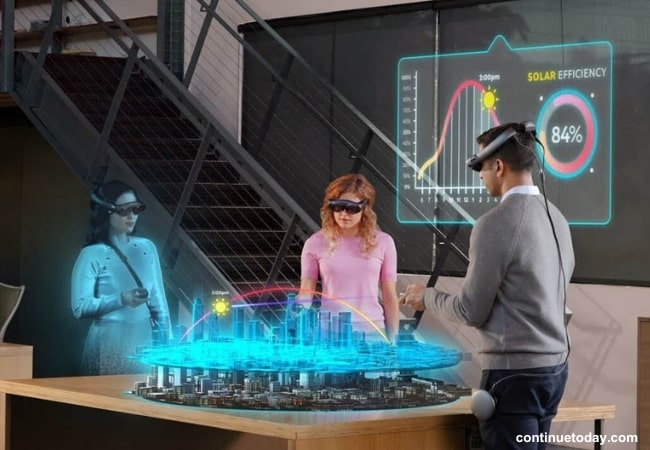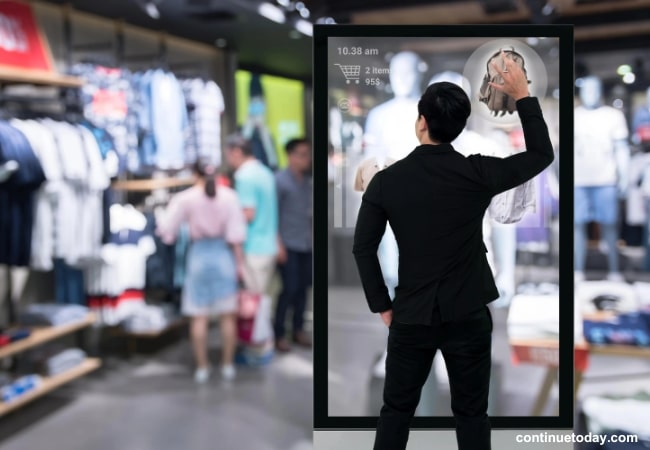It is all part of what is known as “Extended Reality” (XR), encompassing AR, VR, MR, and everything else under virtual and augmented reality suns. Although AR and VR provide unique and ground-breaking experiences, they are powered by the same technologies.
THE WORLDWIDE XR INDUSTRY WAS WORTH US$35.14 BILLION IN 2022.
Precedence Research
IT FORECASTS A CAGR OF 33.09% FOR THE INDUSTRY FROM 2022 TO 2030, RESULTING IN A MARKET SIZE OF ABOUT $345.9 BILLION US DOLLARS BY 2030.
So you can imagine the growth of this fantastic sector of technology. Without further discussion, let’s get into our main topic –
What is Extended Reality?
Many people will interchange the abbreviations AR, VR, and MR to refer to the umbrella term extended reality (XR).
The idea behind this tech is to build a replica of our physical environment, or “digital twin world,” that is just as engaging as the actual thing.
In-depth familiarity with augmented, virtual, and mixed reality is essential for understanding extended reality. So let us begin with the mixture of XR that are –
- Augmented Reality
- Virtual Reality
- Mixed Reality
Augmented Reality

Augmented reality (AR) is a cutting-edge technology that uses AR glasses and computers to blend real-world environments with digital content.
Virtual Reality

Virtual reality (VR) technology employs position tracking and 3D near-eye displays to simulate an alien environment convincingly.
Mixed Reality

Mixed Reality (MR) is used to describe a situation in which real and virtual worlds interact with one another.
How does Extended Reality Work?

The five senses—sight, sound, smell, taste, and touch—are all accounted for in multisensory XR applications.
Light striking the eye’s retina, odor molecules, and pressure waves all contribute to the transmission of impulses through the neurological system that constitute perception.
In fact, in multisensory extended reality applications, you can take in information from your surroundings through your eyes, ears, nose, and skin.
Multisensory extended reality puts a premium on smell since, like in biology, the olfactory system is connected to the sensory nervous system.
Nanoemulsion technology, neuromorphic engineering, cognitive science, positive psychology, neuroenhancement, and positive psychology all play a role in multisensory experiences.
It is a digital therapeutic technology for the care of the limbic system.
Indeed this is one of the outstanding advantages of extended reality.
As a biocentric design, digital therapeutics can use multisensory experiences to improve users’ emotional, mental, cognitive, and behavioral states.
Using the OpenXR and WebXR specifications, multisensory extended reality is possible.
Perception, motor control, integration of several senses, visual systems, head-eye systems, and auditory processing are all part of this.
Technology for interacting between humans and computers. All of these necessitate some form of retinal reverse engineering.
Advantages of Extended Reality
There are some genuine advantages of XR technology available in specific experiences. Let’s get to know about some advantages of extended reality –
- Excellent Instruction
- Effective Training
- Enhancing Customer Experience
- Enabling Telework
- Refined Entertainment
Excellent Instruction

Extended Reality (XR) makes classrooms safer for students and teachers to try new methods.
This is one of the fantastic advantages of XR applications.
Extended reality can improve retention because regular classroom pupils forget 90% of what they learn after a month.
According to a study, Extended reality improves pupils’ comprehension and memory.
Meanwhile, XR is entertaining and educational for people with cognitive limitations or who study best on alternate platforms.
Effective Training
Universities and companies use extended reality technology to provide a good learning environment.
Participation, overhead, and information retention are all advantages of extended reality.
Enhancing Customer Experience

Experiential marketing (XR) lets companies connect with customers and offer new ways to use their products.
Try-ons and demos give customers a better feel for the products than in person.
XR technology can also aid customer service, one of the finest advantages of extended reality.
Enabling Telework
Working remotely remains popular after the COVID-19 outbreak, and it is one of the perfect XR examples also advantages of XR that you may count on.
VR, AR, and MR let workers collaborate better than 2D platforms like Zoom or Skype.
In addition, virtual work offers more opportunities, which may enhance employee and corporate productivity.
Refined Entertainment

Virtual reality meetings are becoming popular as more performers perform online in the entertainment sector. Several 2021 acts explored the metaverse.
This sector will increase as more concerts, conferences, and meetups are held online, which is ultimately one of the best advantages of extended reality.
Sensorium Galaxy, a metaverse with many musical and dance acts, will lead this movement.
Different Sectors of XR Applications
XR applications have a wide variety of real-world uses. Let’s see some fantastic XR examples of its usage for better understanding-
- Retail
- Training
- Putting in time from afar
- Marketing
- Entertainment
- Concerns for People’s Safety
- Homeownership
Retail
With XR applications, consumers may “test drive” an item before purchasing.
For example, IKEA’s smartphone app lets customers virtually arrange furniture in their homes.
In contrast, Rolex’s augmented reality app confidently allows you to try on watches on your actual wrist.
Training

XR’s hyper-realistic training tools can help soldiers, healthcare workers, pilots/astronauts, and chemists solve problems.
The XR examples also help to learn how to respond to dangerous situations without putting anyone’s life in danger. This is especially useful in cases where lives are on the line.
Putting in time from afar
Thanks to technological advancements, employees can now seamlessly connect and communicate with colleagues in remote offices or experts from around the globe.
The goal is to make it feel like the individuals are in the same physical space.
Marketing

Advertising experts will likely consider leveraging XR to connect with clients and customers.
Hence they may use various XR applications to reach a broad level of target consumers.
Entertainment
The entertainment sector, an early adopter of immersive technology, will continue to explore its potential.
Obviously this can be one of the most realistic and suitable XR examples of the contemporary world.
Concerns for People’s Safety

Scientists are researching to identify potential health risks and develop preventative strategies.
Optometric, psychophysical, and self-report assessments were used in the evaluation by Robert Rauschenberger and Brandon Barakat.
They concluded that extended reality must be utilized safely in educational settings despite their efforts to uncover any associated health risks.
Moreover, there has to be more research done taking demographic and environmental factors into account.
Homeownership
Suppose potential buyers or tenants can virtually “walk around” a property from wherever they happen to be.
In that case, this might make the transaction much smoother.
The Problems with XR Technology

Those working on XR technologies face obstacles that prevent their widespread use.
First, it is essential to remember that XR technologies constantly record and analyze sensitive information about your actions, where you look, and even how you feel.
In addition, the implementation costs of the technology need to decrease, or very few businesses would be willing to make the necessary investments.
Lastly, wearable gadgets that provide a comprehensive XR experience must be stylish, convenient, constantly connected, intelligent, and immersive.
Besides For virtual items in the real world are indistinguishable from actual objects.
Especially when lighting changes, substantial technological and hardware concerns exist, such as the display, power and thermal, motion tracking, networking, and shared illumination.
As we move forward, we are rapidly approaching breakthroughs that will enable the seamless integration of XR technologies into our daily lives.
Significant Extended Reality Examples
Virtual reality, augmented reality, and augmented reality can revolutionize various sectors and how people engage with their products.
When brought together, this XR technology will revolutionize the lives of consumers and businesses.
71% OF COMPANIES INTENDED TO BOOST THEIR USAGE OF EXTENDED REALITY TECHNOLOGY IN 2021 AND THE PERCENTAGE INCREASE IS EXPECTED TO PERSIST IN THE UPCOMING YEAR
Sourcing Journal
Many influential businesses are now making use of extended reality. So let’s see all those XR examples from the following:
- BMW
- Honda
- HTC
- Accenture
BMW

The German manufacturer has used VR/AR technology to test autonomous driving.
BMW can speed up the development of autonomous vehicles by testing and simulating many possible scenarios in purpose-built virtual environments.
Honda
Honda uses XR to improve vehicle design visualization, allowing for the creation of remarkable interactive presentations of their automobile designs in a single day.
Indeed one of the most beautiful XR examples you can ask for!
HTC

HTC, best known for its Vive virtual reality headsets, offers a variety of XR business and consumer alternatives across five separate apps: Vive Sessions, Vive Sync, Vive Campus, Vive Social (supplied by VRChat), and Vive Museum.
Accenture
Accenture, a consulting firm, has invested in XR technologies for internal training and assisting clients in developing and rolling out cutting-edge XR experiences at the business level.
Final Thoughts
Extended Reality (XR) might change how we interact with digital and physical media. As it uses real-world and computer-generated images to create sensory and interactive worlds. XR is promising in media, education, healthcare, commerce, and more.
Additionally, XR will allow more realistic and immersive virtual environments via display and haptic feedback improvements. This technology will blur reality and simulation.
So it can be said that XR might transform businesses, schools, social gatherings, and leisure pursuits. It is a promising new field that can help us explore and interact with the world. Virtual reality will change every aspect of human life.
FAQs on Extended Reality
To know more in detail about Extended Reality (XR) you can go through the FAQ section –
XR improves performance and safety by helping students recall and master new skills in a natural setting. Immersive, hands-on XR may help pupils understand complicated subjects. XR can make learning about ancient civilizations, scientific events, and virtual creatures exciting.
XR is used in many industries, such of XR examples are entertainment, gaming, healthcare, business training, education, and shopping. It can make learning immersive and help designers sketch and display realistically. Technology will affect our lives, studies, and interactions.
XR is used in many industries, such as entertainment, gaming, healthcare, business training, education, and shopping. It can make learning immersive and help designers sketch and display realistically. Technology will affect our lives, studies, and interactions.
XR is the result of the combined efforts of several individuals, groups, and companies. Ivan Sutherland created the first HMD in the early 1960s, marking the beginning of XR. Tom Caudell and David Mizell came up with the term “augmented reality” in the 1980s, while Fred Brooks developed the first commercial virtual reality headset in the same decade.
XR has become more mainstream due to its revolutionary potential, wider availability, and investment from large technological firms. It has revolutionized the gaming, healthcare, education, retail, and manufacturing sectors, and has enabled remote collaboration, virtual meetings, and virtual events.





